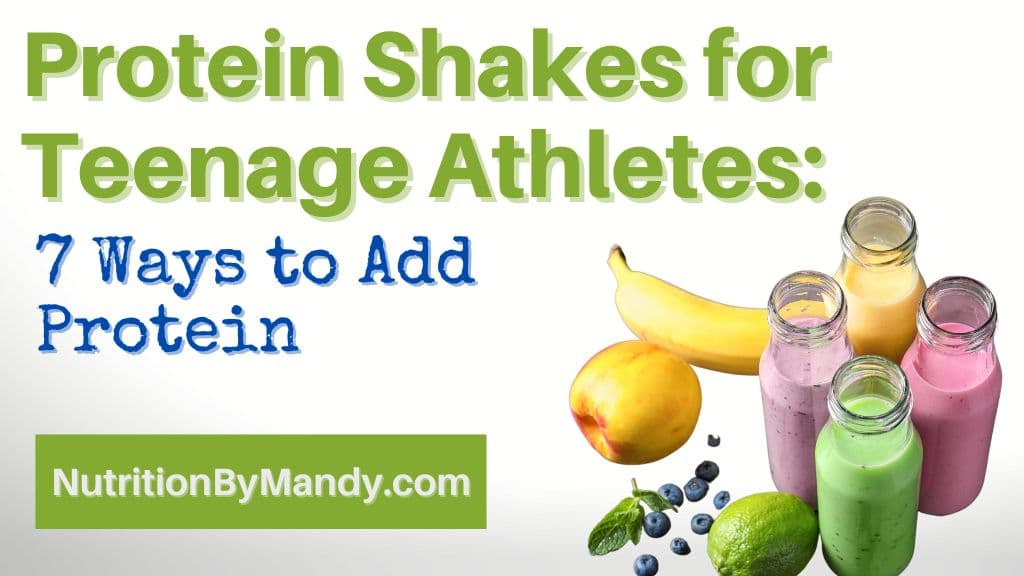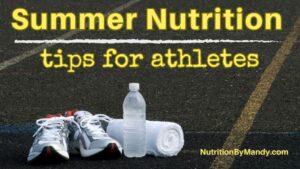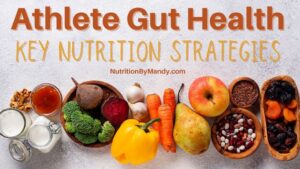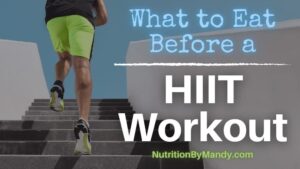Last Updated on April 21, 2024 by Mandy Tyler, M.Ed., RD, CSSD, LD
Protein Shakes for Teenage Athletes: 7 Ways to Add Protein
It is common for teenage athletes to be interested in adding a protein shake to their sports nutrition meal plan. There are numerous ways teen athletes can add protein to their shakes using real food items.
Let’s examine how much protein should be included in a teenage athlete’s protein shake. Then we will look at 7 ways to increase the protein content of the shake.
Making a Protein Shake for Teenage Athletes
Protein shakes can be a convenient way to help teenage athletes meet their protein needs. Using real food items to boost the protein content of the shake can also help teen athletes increase their intake of a variety of vitamins and minerals.
How Much Protein?
When a teenage athlete wants to add a protein shake to their daily sports nutrition plan, the first question should be how much protein to include in the drink.
Protein recommendations for athletes are typically based upon the athlete’s body weight. In addition, to get the most benefit from protein, athletes are encouraged to spread their protein intake throughout the day with several meals and snacks (1).
Although there is limited research in the adolescent athletes, general recommendations are for athletes to consume ~0.3 grams of protein/kg body weight with each meal or snack (2).
This calculates to be in the range of 15-20 grams of protein for most teenage athletes; with larger athletes needing more protein than smaller athletes.
7 Ways to Add Protein to a Teenage Athlete’s Shake
Now that you have an idea of how much protein to include in a teenage athlete’s shake, let’s look at 7 ways to add protein.
Using these real food ideas, teenage athletes can easily meet the target range of 15-20 grams of protein.

#1 Greek Yogurt: Simple Way to Increase Protein in Your Shake
Greek yogurt is a great option for adding protein to a teenage athlete’s shake.
The protein content of Greek yogurt is higher than traditional yogurts. A 5.3 oz individual container of Greek yogurt contains ~13 grams of protein (3).
In addition to protein, Greek yogurt provides calcium and some brands are also fortified with Vitamin D.
Using a vanilla flavored Greek yogurt will give your shake a rich, creamy flavor making it a great delicious addition to a shake.
#2 Ultra-Filtered Milk: Great Addition to Protein Shakes for Teenage Athletes
Ultra-filtered, high-protein milks, such as Fairlife® or H‑E‑B MooTopia®, are an easy way to boost the protein content of a shake.
These milks are filtered to remove the lactose and concentrate both the protein and calcium content of the beverage. To provide a comparison, a cup of regular cow’s milk has 8 grams of protein (4), while a cup of ultra-filtered milk has ~13 grams of protein (5).
If you are looking for a chocolate-based shake, consider using a chocolate flavored ultra-filtered milk. For example, a chocolate, peanut butter, and banana shake made with ultra-filtered milk is a delicious protein shake packed full of nutrition.

#3: Dry Milk: Easy Way to Boost Protein, Calcium, and Vitamin D
Another easy way to boost the protein content of a teen athlete’s shake is by adding non-fat dry milk.
Each 1/3 cup serving of dry milk contains 8 grams of protein (6). In addition to protein, dry milk also contains calcium and is often fortified with Vitamin D.
Keep in mind, however, that dry milk does contain lactose. lactose. If the teen athlete lactose intolerant, you will want to select a different option for increasing the protein content of the shake.
#4 Cottage Cheese: Ideal Addition to Bed Time Protein Shakes for Teenage Athletes
Cottage cheese is a great source of protein, providing ~28 grams of protein per 1 cup serving (7). The majority of protein in cottage cheese is casein protein, which is more slowly absorbed by the body compared to other types of protein (1).
Since casein protein is more slowly absorbed it is often recommended as an ideal protein source to consume prior to bed. If you are looking for additional snacks to have before bed, check out my blog, 5 Healthy Evening Snack Ideas for Athletes.
Even if you are not a fan of the texture of cottage cheese, it blends well into a protein shake. It will not alter the flavor of your shake, but will give it a creamy texture.
If the teen athlete is lactose intolerant, look for lactose-free options, such as Good Culture®’s lactose-free cottage cheese as well as Lactaid®’s cottage cheese varieties, at the store.

#5 Tofu: Plant-Based Source of Protein
Adding tofu to your shake will not only make your shake creamy, it will add protein, vitamins, and minerals.
There are a variety of types of tofu. However, silken or soft tofu is most often used for shakes or smoothies.
Tofu is made from soy milk. Thus, the protein found in tofu is soy protein. Unlike most sources of plant protein, soy protein is a complete protein.
A complete protein contains all 9 of the essential amino acids, which our bodies cannot produce. A 3-oz serving of silken tofu provides ~5 grams of protein (8).
Tofu has a mild flavor and when blended into a shake it will not alter the taste. However, it will give the shake an extra creamy texture making it a delicious addition.
#6 Nut Butters: Add Flavor and Healthy Fats
Nut butters contain protein, unsaturated fats, protein, vitamins, minerals, and phytochemicals, making them a nutritious option to enjoy in a shake. In general, a 2-tablespoon serving of nut butter contains ~7 grams of protein (9).
When selecting a nut butter, choose a product that has limited added ingredients. Some nut butters contain added sugars and hydrogenated oils, making them less healthy choices.
Also be mindful that nut butters are calorie dense, containing ~200 calories per serving. Thus, adding nut butters to a shake will easily increase the total calories of the drink.
Athletes trying to gain weight can include nut butter in a high-calorie shake to help support their weight gain goals.
#7 Chia Seeds: Boost the Nutrients in Protein Shakes for Teenage Athletes
Chia seeds are nutrient dense seeds that provide protein, fiber, omega-3 fatty acids, antioxidants, vitamins, and minerals. A 1-ounce serving of chia seeds provides ~4 grams of protein along with 9 grams of fiber (10).
Chia seeds have a remarkable ability to absorb water and can be easily blended into your shake. This ability to absorb water will give the shake a thicker texture.
Chia seeds do not have much flavor on their own. Thus, putting a few tablespoons of chia seeds into a shake is great way to boost the nutrient profile.
Download my recipe for a cherry berry recovery shake, which includes chia seeds, in my blog on post-workout smoothie ideas for athletes.

What About Protein Powders in Shakes for Teenage Athletes?
In general, teenage athletes should be able to meet their protein needs from food sources. However, for convenience purposes, protein powders may assist with meeting sports nutrition needs when time is limited.
As a reminder, supplements are intended to “supplement” the diet. Supplements should not take the place of whole foods and a well-balanced sports nutrition meal plan.
Evaluating Sport Supplements for Teenage Athletes
If you are considering a protein powder it is important to know that supplements are not regulated by the Food and Drug Administration in the same way that food is. Sport supplements could potentially contain banned substances that are harmful to your health or that make you ineligible for competition (11).
Due to this, look for supplements that have been third-party tested. Supplements that are third-party tested have an outside organization evaluate the supplement for accuracy of ingredients.
Two companies that evaluate sports supplements are NSF International Certified for Sport and Informed Sport.
In addition, I recommend looking for a protein powder with limited added ingredients aside from the source of protein.
When using protein powder in a shake, be aware of how much protein is in one scoop of the protein powder. Recognizing that a teenage athlete only needs 15-20 grams of protein in the shake, athletes may not need to include one full scoop of the protein powder.
If athletes are mixing the protein powder into milk or adding in other sources of protein, such as Greek yogurt or nut butter, it is important to factor in the protein content of these items when calculating the total protein in the shake.
Boosting the Nutrient Profile of the Teenage Athlete’s Protein Shake
Adding a variety of fruits, leafy greens, and spices is a great way to add fiber, vitamins, minerals, and antioxidants to a teenage athlete’s protein shake.
Consider the ideas below for boosting the nutrient content of a protein shake.

Frozen Fruit
Fruit is a nutrient-rich addition to a teenage athlete’s protein shake. Frozen fruit is flash-frozen at the peak of ripeness. Thus, frozen fruit maintains a nutrient content similar to fresh fruit.
I encourage athletes to keep a variety of frozen fruit on hand in their freezer. Some of my favorite for creating a healthy fruit smoothie include: mixed berries, mango, peaches, pineapple, and sliced banana.
Leafy Greens
Adding leafy greens to a teenage athlete’s protein shake, such as kale and spinach, is a great way to boost the drink’s nutrient content.
When adding greens to a shake, be aware that they will turn the shake a brownish, green color. However, it will not alter the flavor of the shake and is a simple way to add-in vitamins and minerals.
Spices
Spices are a great way to enhance the flavor and nutritional content of a protein shake.
Consider adding cinnamon, nutmeg, turmeric, or ginger to a teenage athlete’s protein shake to spice things up.
Make Your Protein Shake!
You now are equipped with a variety of ways to add protein to a shake for teenage athletes
For additional suggestions on ways to meet your performance nutrition needs visit with a sports dietitian nutritionist. The sports dietitian nutritionist can work with you on developing a customized plan to support your training and performance goals.
If you have a teenage athlete looking for ideas to support weight gain, check out my blog: 7 Nutrition Tips to Support Weight Gain in High School Athletes.
Join the Nutrition By Mandy Email List & Get a Free Athlete’s Grocery List
Click HERE to join the Nutrition By Mandy e-mail list. When you join you will receive a free athlete’s grocery list to print and take with you to the store.
About the Author
Mandy Tyler is a Sports Dietitian Nutritionist in the San Antonio, TX area. She is a Registered and Licensed Dietitian, a Board-Certified Specialist in Sports Dietetics, a Licensed Athletic Trainer, and is a Certified Exercise Physiologist through the American College of Sports Medicine. Mandy has experience working with athletes at the high school, collegiate, and professional levels. She believes the key to reaching one’s full potential, both in everyday life and in sports performance, relies on a healthy nutritional foundation.
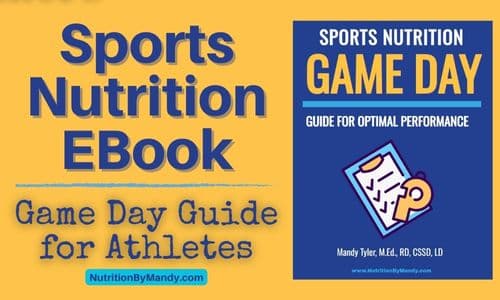
If you are looking to take your performance to the next level, make sure to check out my new Sports Nutrition Game Day Guide. This downloadable guide is written to help athletes develop an individualized plan to achieve peak performance on game day.

